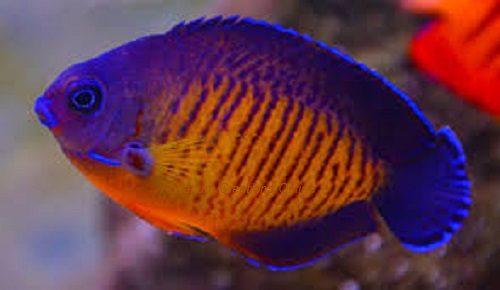Identification:
The Coral Beauty Angelfish are easy to care, very hardy and generally good eaters. They will take all manner of offered foods and graze on hair algae on live rock. Other common names they are known by are the Twospined Angelfish, Dusky Angelfish, and Two-spined Angelfish. The Coral Beauty Angel needs a mature tank that is a minimum of 70 gallons with plenty of live rock and algae growth. Place the rock work with multiple places to hide so they will feel secure enough to come out often. This will provide security, and the more secure it feels, the more it will come out into the open.
This is a hardy dwarf angel that is generally resistant to disease and a relatively peaceful fish. The Coral Beauty is as intelligent as the larger angelfish and will only be a terror if kept in a smaller tanks where it feels it must defend its little piece of the reef. It can be kept in a spacious community aquarium with fish of a similar size and disposition, and lots of hiding places. They do very little or no harm to invertebrates, although they may be inclined to occasionally peck at tubeworms or coral polyps. It is generally better behaved with corals than other Centropyge dwarf angels. Coral Beauty Angels may nip at LPS and clams, but if they are properly fed they will often ignore corals. According to one source they control many types of growth including certain species of diatom algae; Ulva , some species of Derbesia, and Entermorpha .
Unlike other dwarf angels, the Coral Beauty Angelfish does not pick on smaller tank mates unless there is competition for algae in a smaller tank. Two Coral Beauty males will fight to the death. They do not get along with other dwarf angels unless the tank is well over 100 gallons and there are plenty of hiding places and food for both to eat. Making 2 separate "reefs" in a longer tank helps to "divide the line" so to speak. The Coral Beauty Angelfish is the least likely of all dwarf angels to bother corals when housed in larger tanks.
All Coral Beauty Angelfish are born female and can be paired according to size, not necessarily color. The larger fish becomes male, so making a pair is possible by buying a larger Coral Beauty and a smaller Coral Beauty, and within a few months hopefully they will assume their roles as male and female. Dwarf angelfish will spawn in captivity and some are now being raised, yet raising the larvae is quite a difficult task.
Food and Diet:
Dwarf Angelfish are omnivore's. In the wild it feeds primarily on algae, but it will also ingest tiny animals living in the algae. In captivity their diet will be mostly algae, but also offer some other proteins. Feeding them a variety of good foods is important. Offer various types of fresh and dried marine algae, spirulina enriched foods, mysis shrimp, shaved shrimp and other high-quality meaty foods, angelfish preparations, and flakes or pellets designed for algae eating fish. There are several good commercial foods available including Formula II and Angel Formula. Feed several times a day even if natural foods are present.
Level of Care:
Beginner
Aggressiveness:
Semi-aggressive
Recomended amount of drip acclimation time:
3+ hours
Reef Compatibility:
With a good deal of Caution
Approximate Purchase Size:
Small: 1" to 1-1/2"; Medium: 1-1/2" to 2-1/2"; Large: 2-1/2" to 3-1/2"
|


